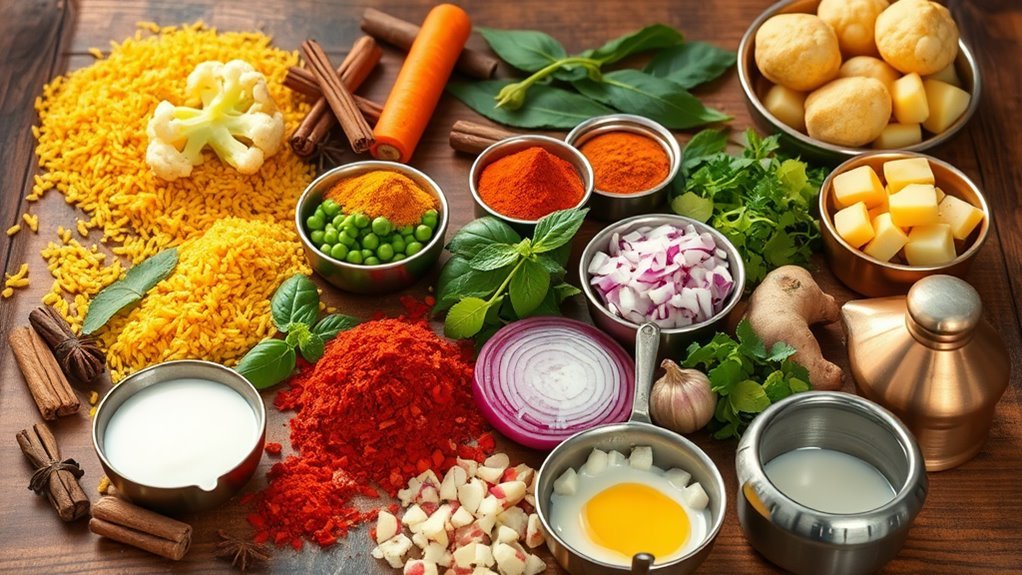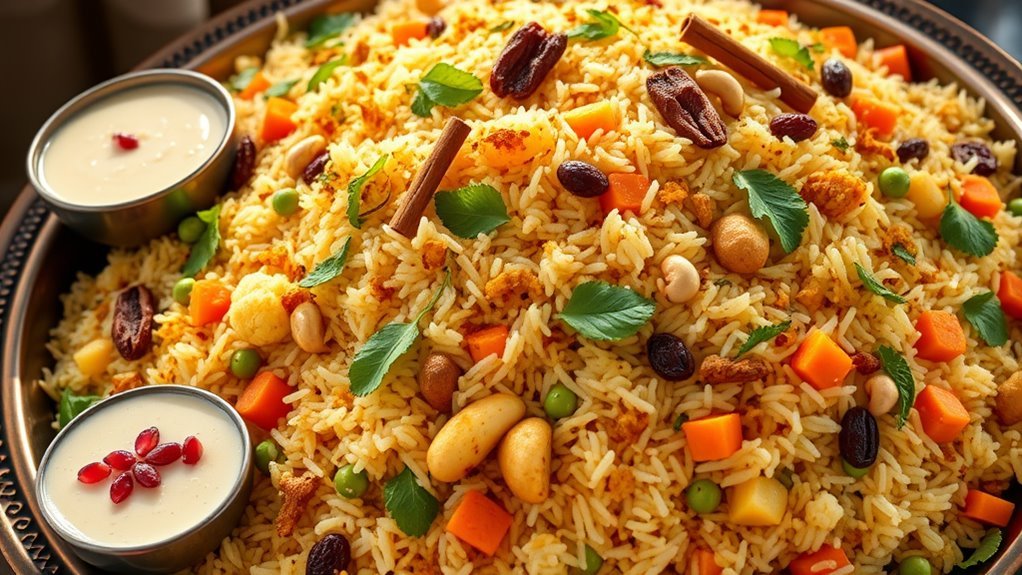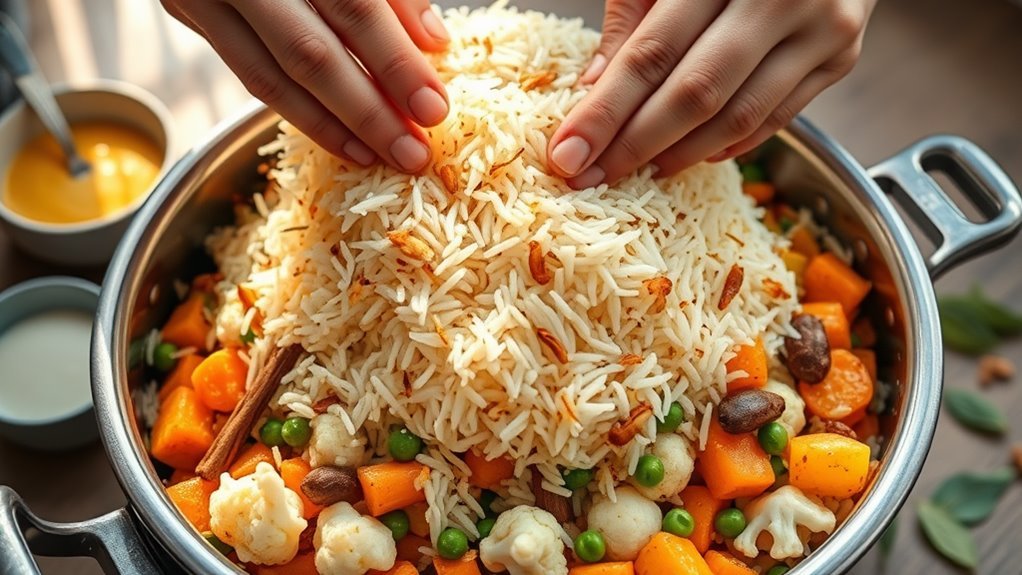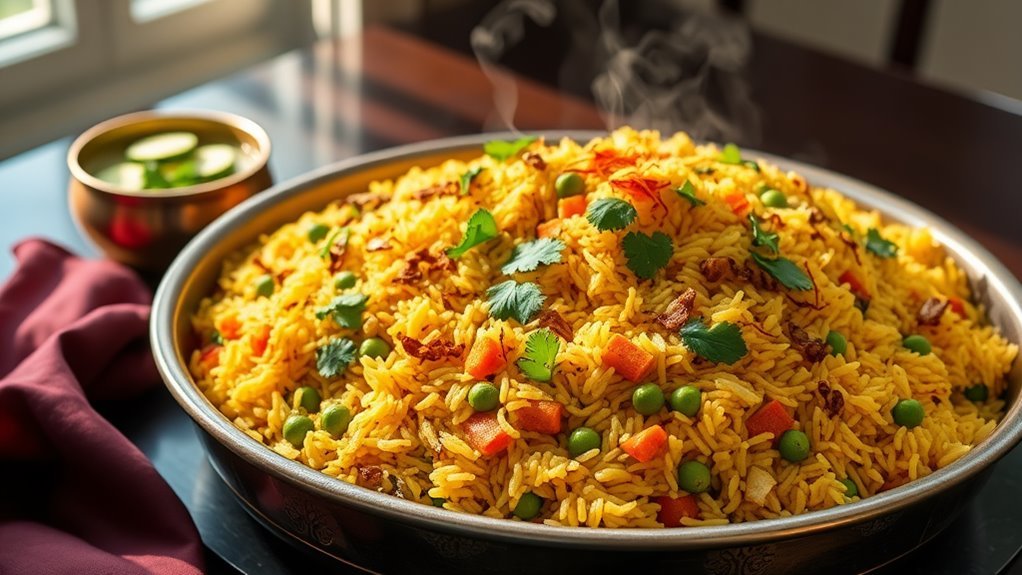Alright folks, gather ’round! We’re diving into the delightful world of vegetable biryani today. This isn’t just any rice dish; it’s a colorful, aromatic symphony of flavors that has won hearts not just in India but all over the globe. Now, don’t let the fancy name intimidate you. We’re going to whip this up using simple ingredients—just good old rice and some fresh veggies.
I’ll take you through some classic techniques and let you in on a few spice secrets that’ll make your kitchen smell like a street market in Delhi. Trust me, whether you’re a whiz in the kitchen or just starting to figure things out, this dish is all about comfort and a touch of elegance. So, roll up those sleeves and let’s uncover the art of biryani together, one tasty layer at a time!
Ingredients

A traditional vegetable biryani relies on three fundamental components: aged basmati rice as the fragrant base, a carefully selected blend of whole spices for aromatic depth, and fresh vegetables cut to specific sizes for even cooking. The rice, preferably aged for at least 6 months, is soaked before cooking to guarantee proper grain separation, while whole spices like cardamom, cloves, and cinnamon are gently toasted in oil to release their essential oils. The vegetable selection typically features a mix of firm and tender varieties, cut to maintain their integrity during the layered cooking process. For enhanced richness and flavor infusion, dum cooking method allows the ingredients to simmer together slowly under a sealed lid.
| Ingredient | Quantity | Notes |
|---|---|---|
| Basmati Rice | 2 cups | Aged minimum 6 months |
| Cardamom | 4 pods | Green variety |
| Cloves | 6 pieces | Whole |
| Cinnamon | 1 inch stick | |
| Bay Leaves | 2 pieces | |
| Carrots | 2 medium | Cubed |
| Green Beans | 1 cup | Diagonal cut |
| Green Peas | ½ cup | Fresh or frozen |
| Cauliflower | 2 cups | Large florets |
| Potatoes | 2 medium | Cubed |
| Shahi Jeera | ½ tsp | |
| Water | 3-4 cups | For cooking rice |
Recipe

A fragrant and flavorful vegetable biryani combines aromatic basmati rice with seasonal vegetables in a harmonious blend of Indian spices. The layering technique and pressure cooking method guarantee each grain of rice is perfectly cooked while the vegetables retain their texture and nutritional value. Serving with onion raita creates a perfect accompaniment to balance the spicy flavors.
This one-pot meal is both convenient and satisfying, traditionally prepared with a mix of fresh vegetables and warming spices. The combination of pre-soaked rice and precise water proportions creates the ideal consistency, while the addition of yogurt helps keep the dish moist and adds a subtle tanginess.
| Ingredient | Quantity |
|---|---|
| Basmati Rice | 2 cups |
| Mixed Vegetables | 3 cups |
| Yogurt | 1/2 cup |
| Ginger-Garlic Paste | 2 tbsp |
| Green Chilies | 2-3 |
| Onions | 2 medium |
| Tomatoes | 2 medium |
| Garam Masala | 1 tbsp |
| Turmeric Powder | 1 tsp |
| Oil/Ghee | 4 tbsp |
| Salt | to taste |
Soak the basmati rice for 30 minutes, then drain. Heat oil in a pressure cooker, sauté onions until golden. Add ginger-garlic paste, green chilies, and tomatoes. Mix in the vegetables and spices, cooking for 2-3 minutes. Layer the rice over the vegetables, add water and yogurt in the correct proportion (1:1.5 rice to water ratio). Close the pressure cooker and cook for one whistle on high heat, then immediately release pressure manually. Let it rest for 5 minutes before gently fluffing the rice.
For best results, verify the rice isn’t oversoaked as it can become mushy. The vegetables should be cut uniformly to confirm even cooking. Always layer the rice on top of the vegetables rather than mixing them together initially. If using paneer, add it as the final layer to prevent it from becoming too soft. The biryani can be garnished with fried onions and fresh coriander before serving.
Cooking Tips

To create perfect vegetable biryani, mastering essential cooking techniques will elevate your dish from good to exceptional.
We’ll start by soaking our basmati rice for 30 minutes – this vital step guarantees perfectly separated grains. Our recipe draws from Medieval Indian cuisine, reflecting its rich historical origins.
When layering, we’re creating a symphony of textures by alternating rice, veggies, and crispy fried onions.
Don’t forget to seal your pot with dough or foil for that authentic dum cooking method!
For maximum flavor, we’ll marinate our veggies in aromatic spices and drizzle each layer with saffron milk and ghee.
History

While many assume biryani must contain meat, the fascinating history of vegetable biryani reveals a rich tapestry of cultural fusion and innovation.
We can trace its roots to the Nizams’ courts, where Hindu bookkeepers working under Muslim rulers needed meat-free options. This led creative chefs to develop vegetarian versions using aromatic spices like cumin, cardamom, and turmeric. The slow-cooking process “dum” ensures flavors meld perfectly as rice and vegetables cook under pressure.
The dish evolved further through various influences – from Persian origins to coastal trade impacts.
Biryani’s journey weaves through Persian kitchens and coastal ports, absorbing flavors and techniques from diverse culinary traditions.
Through famines and food shortages, communities adapted by incorporating local ingredients like potatoes in Bengal, proving biryani’s remarkable ability to transform while maintaining its essence.
Final Thoughts

Understanding vegetable biryani’s nutritional profile helps us make informed decisions about this beloved dish. We can enjoy its delicious flavors while being mindful of portion sizes, especially with packaged versions that tend to be higher in sodium and fats. With vitamin A and C being abundant in this dish, it provides important nutrients for maintaining overall health.
Whether we choose homemade or store-bought options, we’ll want to balance the carb-heavy nature of biryani by adding protein-rich sides like dal. For those watching their diet, there’s always room for creative adaptations – try brown rice or quinoa, load up on vegetables, and experiment with yogurt-based preparations that maintain authentic taste without compromising health benefits.

